Swarm control - it's not rocket science

The majority of visitors (~85%) to this site are from the Northern hemisphere – the UK, USA, Canada and Ireland. Everyone is welcome of course, but the reality is that the topical posts that appear are in sync with the season in the Northern hemisphere, so they tend to get read more. Nowhere is this more apparent than during the period when our bees are swarming – or attempting to swarm.
I wrote Queen cells … don’t panic! back in June 2018. It described what queen cells looked like and what to do if you find them (Don’t panic!). It wasn’t read much that year but has gradually gained ‘traction’ and last year accounted for ~4% of all visits {{1}}.

Seasonal reading about queen cells
The page views show distinct seasonality, with peaks in May coinciding with beekeepers panicking when they find queen cells our swarm season in the Northern hemisphere.
This year, swarming in the UK made the news with an article on the BBC about Midlands beekeepers running out of equipment. It was an enjoyable read – I used to keep bees there and know the beekeepers – not least because of all the errors made by the reporter. I counted about half a dozen clangers {{2}} in under 300 words.
I discussed swarm control and clipped queens last week and have been meaning to produce a relatively simple overview of the principles and practice of swarm control. The intention is that this is relatively ‘high level’, linking to previous relevant posts. In addition, I was back in my Fife apiaries on Tuesday and there are a couple of relevant observations to include in the post today.
Inspection frequency
It’s worth remembering that many of the things we do in terms of colony management – in particular during swarm control and queen rearing – are determined by the development cycle of the queen.
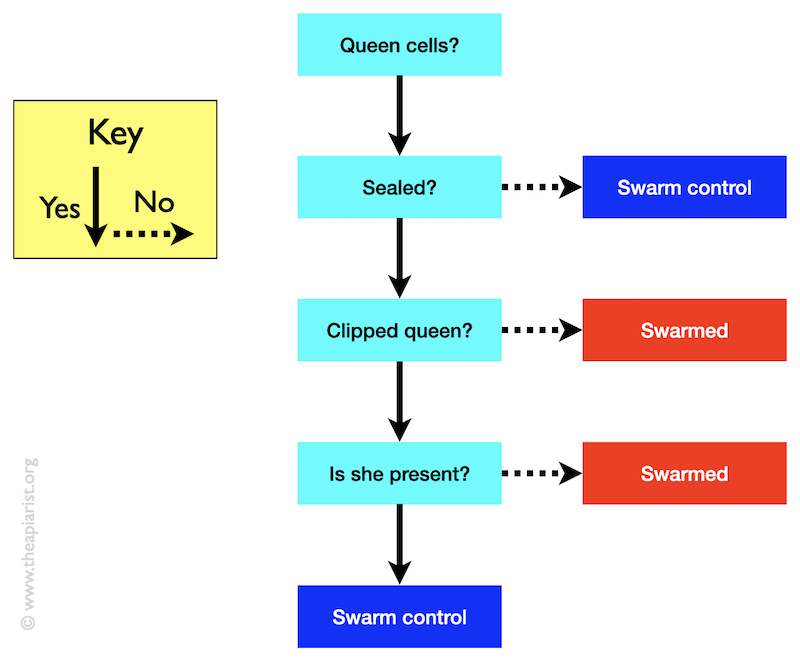
Inspections and decision making
From egg to emergence this takes 16 days. From the egg being laid until the cell is sealed (when pupation starts) takes 8 days.
Swarming is honey bee reproduction. The goal is to generate (at least) one new colony.
Swarming involves the queen and a large proportion (up to 75%) of the workers leaving to set up a new nest. It’s a risky process and most swarms do not survive. Thomas Seeley’s observations in the Arnott Forest suggest that ~75% perish.
Therefore, since the swarm may not survive it is important that the swarm does not leave before the survival of the original colony is almost assured.
And that occurs once the developing cell is sealed.
Which is why a colony will usually swarm on or shortly after the day that the first queen cells are sealed, i.e. 8 days after the selected egg was laid.
All of which, in a rather convoluted manner, explains why a 7 day inspection frequency is necessary.
If you carefully inspect the colony every 7 days they are very unlikely to swarm before your next inspection if there were no queen cells when you last inspected.
If they do swarm it means either a) you missed a queen cell, or b) they swarmed early.
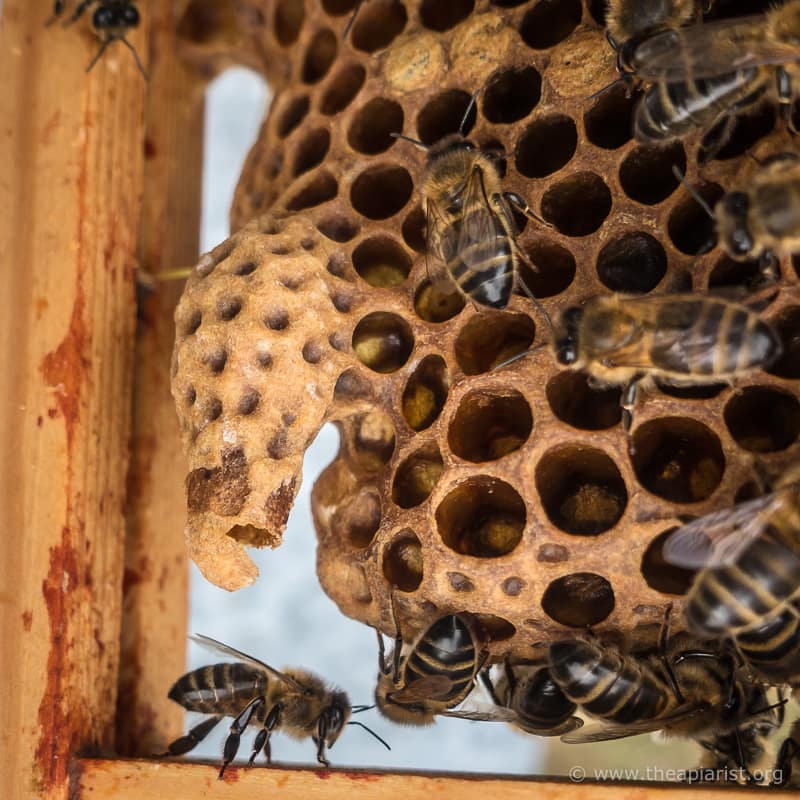
She’s gone …
When I ask, many beekeepers of swarmed colonies assure me that they ‘went early’.
Since a few million years of evolution have resulted in the swarming behaviour of honey bees I remain slightly sceptical that the beekeeper didn’t overlook a cell tucked away somewhere under a writhing mass of bees 😉 .
’Usually’
Since we’re talking about bees, all the normal caveats apply.
Swarming will be delayed by lousy weather … why set off into the great unknown if it’s cold and wet? They usually swarm on the day the cell is sealed, but if it rains for a week they’ll wait.
But if you then get a fine, warm, dry day after a period of poor weather everything can go a bit crazy.
Clipped queens
The other thing that delays swarming is the clipping of one wing of the queen. This gives you a few days leeway (but perhaps not 12 as I described last week) and Ted Hooper (in Guide to Bees and Honey) explains that – mathematically – a 10 day inspection cycle of colonies with clipped queens means you should never lose a swarm.
The important assumption made in the last statement is that your inspection is thorough enough to find any queen cells that are present.
I you miss one, then all bets are off … and so might be the swarm 🙁 .
But the swarm headed by the clipped queen can’t actually go anywhere and usually returns to the hive, so giving the beekeeper a few extra days grace.
In terms of longevity and fecundity there is no evidence I’m aware of that clipped queens are compromised in any way. Therefore queen clipping helps me avoid losing swarms, the majority of which have a rather uncertain future:
- some voluntarily occupy a bait hive
- others are re-hived by a beekeeper when bivouacked, or
- re-hived by a beekeeper after doing a ‘cutout’ from a building
- some get established in a new nest site not managed by a beekeeper, but
- a proportion fail to find a suitable nest site
Of these, the first three involve increasing amounts of effort by the beekeeper (perhaps associated with decreasing likelihood of survival?), but the last two are unlikely to result in long-term survival.
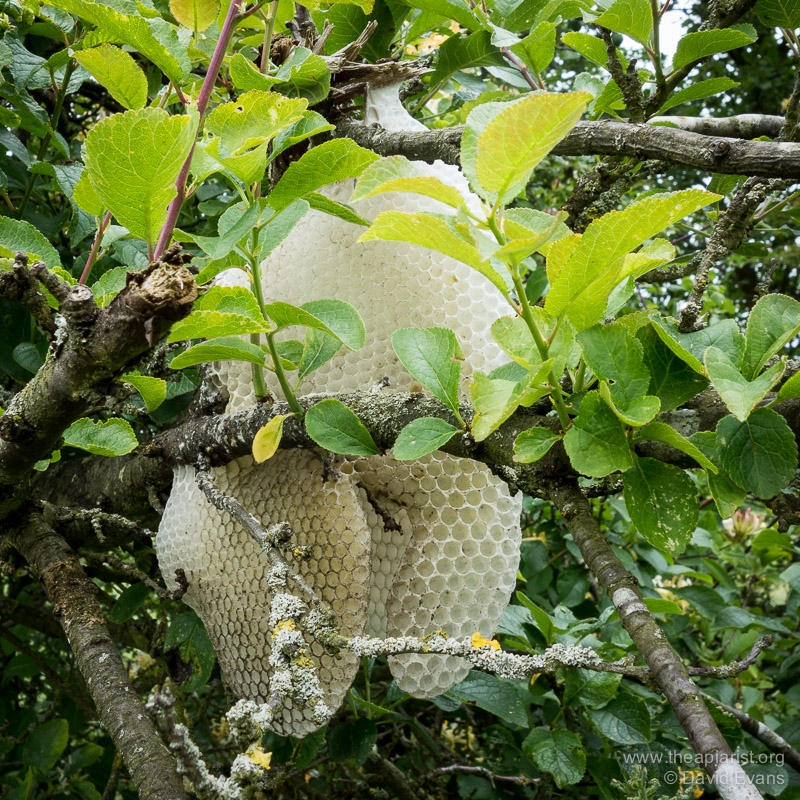
A colony settled here and subsequently perished
I’d be very interested to know the percentages of swarms for each of these 5 categories … have any readers an idea?
My guess … 5%, 20%, 5% respectively, with the remaining 70% remaining ‘at large’.
The swarm under the shed
A brief aside since I’m talking about clipped queens.
I did manage to entice (where ‘entice’ means smoke to the point where she had not choice but to move) the clipped queen from under the shed into a nuc box. I checked the box on Tuesday. The bees had drawn out the foundation and built worker comb under the super frame I’d included in the box.
Remember that in a full sized hive bees often add brace drone comb under an added super frame. However, in the case of a swarm in a nuc the priority is to expand quickly, so they build worker comb instead. Drones are no use to them.
The queen had laid up at least two complete frames and two others were almost full of nectar … the flow has been spectacular for the last 10 days or so.
I took an endoscope camera and had a look under the shed. There were tiny bits of comb just started suggesting that the bees hadn’t been there long.
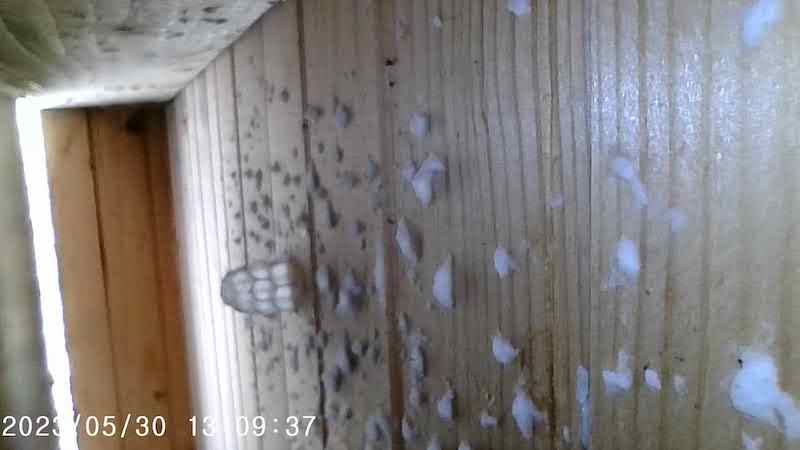
Swarm wax remnants on underside of shed floor
You’ll often see little crescent shaped bits of wax where a swarm has resided – for example, on a branch you’ve recovered a bivouacked swarm from, or even inside a skep.
The principles of swarm control
When trying to understand swarm control it’s worth thinking of the bees in terms of ‘potential viability’ where viability means long term survival.
For example, is a queen – on her own – potentially viable?
No.
She needs the support of workers to feed her and to rear the brood from the eggs she lays.
What about the ‘flying’ bees (i.e. the foragers)? These are the bees that have orientated to the hive’s location and return after a foraging flight, in contrast to the nurse (hive) bees which have never left the hive {{3}}.
No again, they cannot usually lay eggs and the eggs they do (rarely) lay are unfertilised and develop into drones {{4}}.
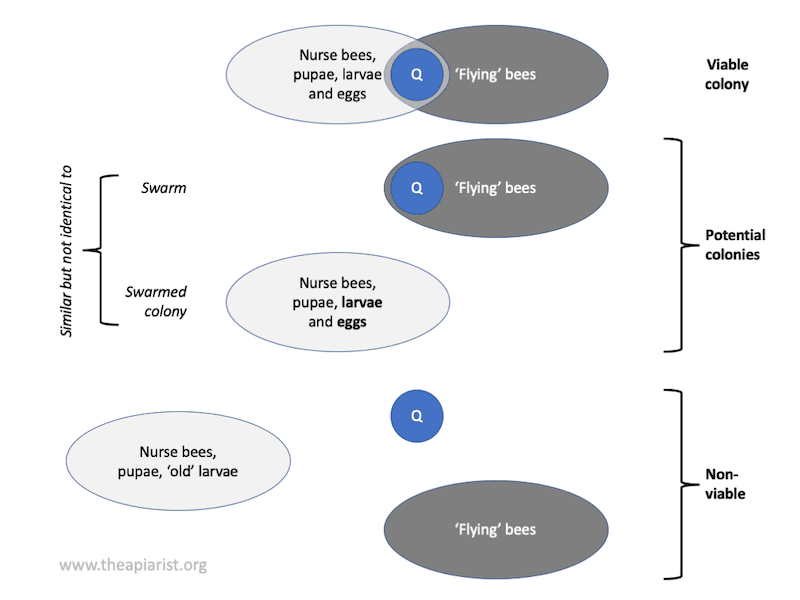
The principles of swarm control
There are only two subdivisions of the colony which retain potential viability:
- the queen plus the flying bees {{5}}
- the nurse (hive) bees plus the brood (with the caveat that the brood must include eggs and/or very young larvae)
The majority of swarm control methods involve the separation of the full colony into these two subdivisions, together with management of queen cell numbers.
The queen supported by the flying bees can build comb, forage, lay eggs and rear brood. If they do enough of all these activities the colony should be viable.
Similarly, although the nurse bees and brood have no queen, they have eggs and young larvae from which they can rear a new queen and so are also potentially viable.
Swarm control in practice
With one notable (common) exception, swarm control involves separating the nurse bees and brood from the queen and flying bees.
Let’s briefly mention the exception first, which I’ll return to later. The exception is the nucleus method of swarm control. This involves removing the queen and a frame or two of bees and brood from a colony containing queen cells. The latter rears another queen whereas the nuc with the queen builds up into a new colony {{6}}.
OK, how do you simply separate the queen plus flying bees from the brood plus nurse bees?
There was a hint earlier when I mentioned the fact that the flying bees know where the hive is, whereas the nurse bees – having never left the hive – do not.
Therefore, if you move the soon-to-swarm hive away from it’s original location and put a new box in its place, the flying bees – over a few hours – will return to the new box. It might even take a day or so … the foragers will set off from the moved hive (and many only make infrequent foraging trips) but return to the new box on the original site.
As a consequence, the original hive gets depleted of flying bees. This helps reduce the pressure to swarm.
The flying bees move themselves if the beekeeper moves the hive … what about the queen?
You have to move her.
Rather than handling the queen directly this is usually achieved by moving the frame containing the queen (but no queen cells) into the new box in the original location.
Swarm control methods
I’ve described a handful of swarm control methods, three of which involve manipulation of the hive to split the colony into the two subdivisions (queen plus flying bees and nurse bees plus brood) described above.
I’ll write a few words about each of these methods, but you should read the original linked posts for all the gory details.
Pagden’s artificial swarm
As taught in draughty church halls every winter by most beekeeping associations. This involves the horizontal separation of the original hive and the new hive. It requires a complete duplicate hive – floor, brood box, crownboard and roof – and a bit of space on either side of the original location.
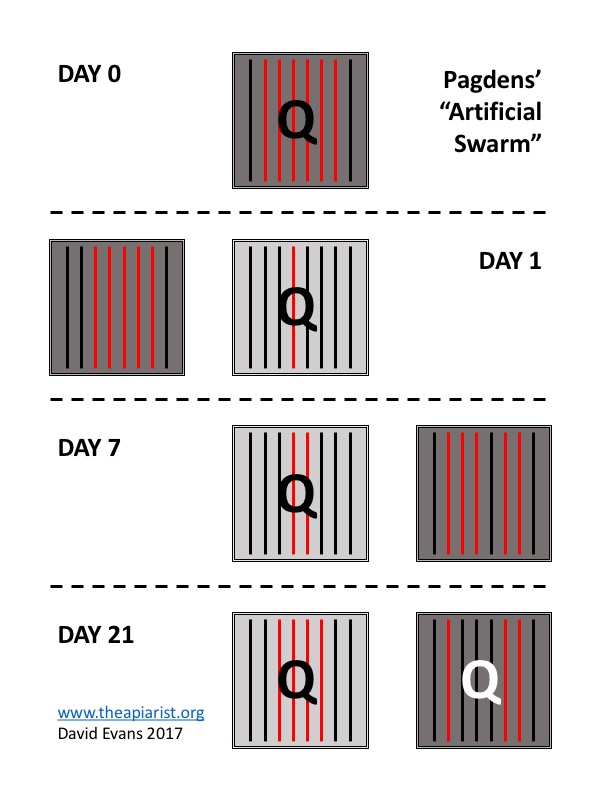
Pagdens’ artificial swarm …
The disadvantage in my view is the space required and the additional equipment needed. You may not have enough of either.
The vertical split
This achieves the same thing but does so using less equipment and space. The ‘moved’ box is reversed, provided with a new entrance and stacked on top of the original hive. As a consequence the foragers fly out of the back of the hive, but return to the front, entering a brood box into which the queen has been placed.
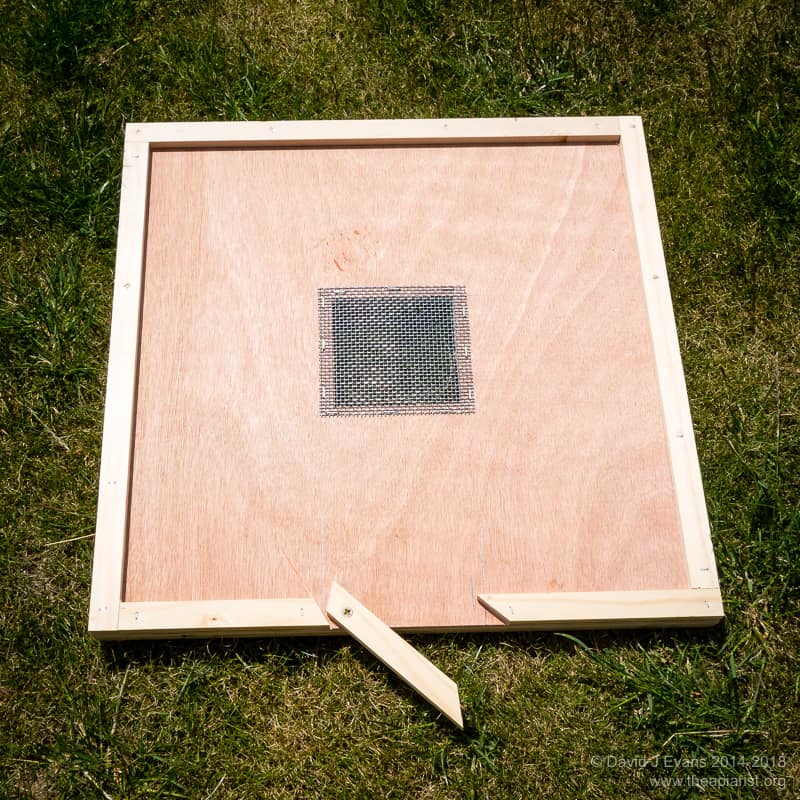
Split board …
The advantage in reduced equipment (you only need a spare brood box and a ‘split board’ … which could be as simple as a sheet of polythene) and space are somewhat outweighed by the amount of lifting involved when working with a hive containing several supers. This will be influenced by how strong you feel. I used to favour this method but now use the nucleus method.
The Demaree method
This is a bit like a vertical split without the split board and upper entrance. As originally described it also differs in that it does not result in the production of a new queen. The queen is in the bottom box and the upper brood box (containing brood and nurse bees) is separated by queen excluders and a couple of supers. The queen cells in the upper box are knocked back and, over time, the brood emerges and moves down through the stack to join the queen. Again there are space and equipment advantages, but the top brood box can get backfilled with nectar during a strong flow and drones get trapped above the queen excluder and perish.

Demaree swarm control
This seems to be a Marmite method of swarm control … some beekeepers love it and use it all the time, others dislike it (tall stacks of heavy equipment, missed queens emerging in the top box and dead drones) and avoid it like the plague. I’ve used it successfully, but not enthusiastically.
The nucleus method
Unlike the previous methods outlined above, this method makes no attempt to separate the queen plus flying bees from the rest of the hive. Instead it involves removal of the queen plus sufficient bees to establish a new colony – 2-3 frames under normal conditions, none of which must have any queen cells – coupled with culling of all but one or two queen cells in the original hive. Ideally this is achieved with two visits ~7 days apart; on the first visit the nuc with the queen is made up and on the second all but one or two queen cells are removed. The delay ensures there are no eggs or larvae young enough to rear a new queen from, so preventing the colony producing cast swarms.
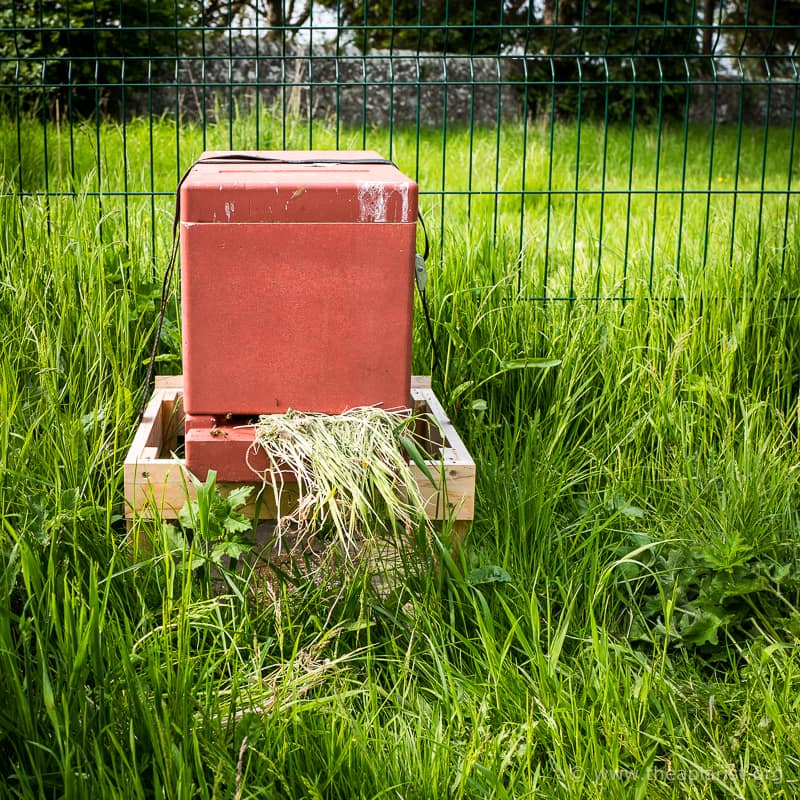
Here’s one I prepared earlier
This method has a number of advantages in my view; it requires minimal additional equipment and almost no additional lifting (a big plus!). With care it is effectively foolproof. The queen is safe and you control the production of queens in the original hive. The only major disadvantage (particularly when compared with the methods above) is that it helps to be able to move the nuc to a distant apiary, so preventing loss of bees back to the original hive. However, this is relatively easy to solve.
Putting the ‘artificial’ in artificial swarm
As a final aside in this rambling discourse, it’s worth noting that none of the three swarm control methods that separate the queen plus flying bees from the brood plus nurse bees recapitulate a natural swarm.
By adding coloured spots to different cohorts of emerging workers – red for the 25th of May, blue for the 26th, pink for the 27th etc. {{7}} – you can determine the average age of bees in a colony. If that colony swarms (and you capture the swarm) you can also determine the average age of bees in the swarm.
It’s not the same.
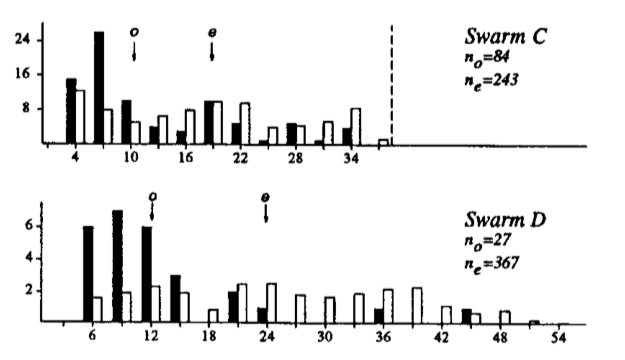
Age distribution of bees in swarms (click for legend)
A natural swarm does not contain 50-75% of the workers selected randomly. If it did it would have the same average age (and distribution) as the original colony.
Perhaps surprisingly a natural swarm does not predominantly include the older flying bees from the colony. Instead it is biased towards the younger bees with the average age of bees in the swarm 7-12 days less than those in the hive.
This raises some interesting questions:
- what proportion of bees in the swarm have not been on prior orientation flights?
- if so, is the amnesia of swarms (they can be moved anywhere when bivouacked) related to this ‘younger’ age distribution?
- but how do these bees find their way back to the hive if a clipped queen crashes into the grass and is lost?
In contrast, an artificial swarm {{8}} predominantly contains older flying bees. Thankfully bees display ‘plasticity in temporal polyethism’ (!) meaning older foragers revert to being nurse bees for brood rearing and comb building, so our artificial swarms can behave like natural swarms.
But I can’t find the queen 🙁
All the artificial swarm methods outlined above involve finding the queen and manually moving her (on her frame) to a new box {{9}}.
What happens if you cannot find the queen?
Typically, colonies that are making swarm preparations are strong colonies. Finding an unmarked queen in a 40 litre box containing perhaps 25-30,000 bees is not straightforward. Even if the queen is marked it can be tricky.
Pagden’s artificial swarm with an undetectable queen
I failed to find a marked queen in a very strong colony on Tuesday.
I did find charged queen cells and lots of eggs (and a huge number of workers) so I was sure the colony had not swarmed.
Under these conditions you can still perform an artificial swarm albeit with one minor modification.
I’ve described the process in detail in Swarm control and elusive queens. Essentially you do a Pagden artificial swarm but you ensure that the new box on the original site is provisioned with a frame or two of eggs and young larvae but (as usual and importantly) no queen cells.
The flying bees return to the new box, the rest remain (with the queen cells) in the moved box.
The queen is more likely to be in the moved box (since you only removed one or two frames), but the depletion of flying bees should mean they tear down the queen cells and don’t swarm. The eggs and young larvae you provided in the new box are used to rear a new queen.
Alternatively, if the (undetectable) queen was moved to the new box it’s exactly the same as doing a Pagden artificial swarm.
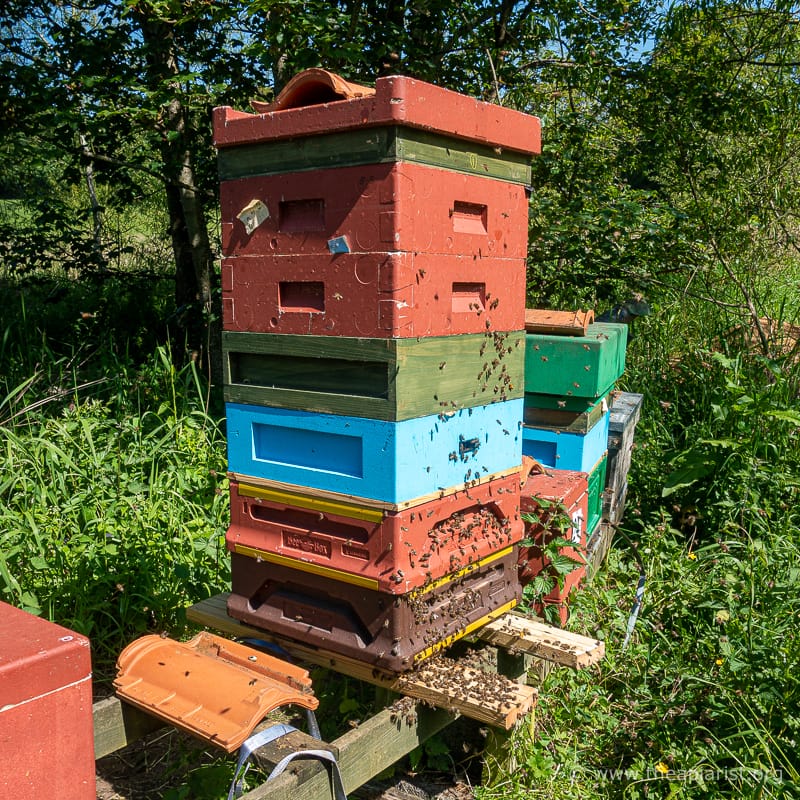
New box on the original site (swarm control when you cannot find the queen)
I’m almost certain my undetectable queen remained in the moved box as the returning workers were less enthusiastic to enter the new box on the original site.
I’ll find out next week 🙂 .
In theory you could do this vertically but, with four supers and an already wobbly hive stand, it would be tempting fate.
Swarm control is not rocket science
Regular inspections at an appropriate frequency, coupled with prompt and decisive action should you find queen cells, are all that are needed to control swarming.
The inspection cycle is determined by the time takes a new queen to develop. That is invariant. Since you cannot influence it your only choice is whether to inspect every 7 or 10 days, depending whether you clip the queen or not. This frequency may appear onerous {{10}} but is only needed during the period colonies are likely to swarm. By late June I’m usually inspecting every fortnight or so.

Spectacular hawthorn blossom this spring
The swarm control method you employ is based upon very simple principles. Understand these and all of the ‘new box on the left, rotate the entrance, stand on one leg and align frames with ley lines’ instructions {{11}} should make sense.
If you understand the principles you will be able to arrange the boxes correctly even if you cannot remember the precise order of the instructions from your training … does the new box go on the left or right? Which leg? What’s a ley line?
Four final ‘top tips’ :
- knocking back queen cells is not swarm control. They will swarm as you will miss a cell, or they’ll subsequently ‘swarm early’ on an open cell. Don’t … just don’t.
- and related to the above … do not knock back any queen cells until you know whether the colony is queenright or if there are eggs and young larvae present from which a new queen could be reared. This is a classic mistake and can leave the colony in a terminal state only recoverable by purchasing a new queen or scrounging a frame of eggs from another hive (or beekeeper).
- learn one method of swarm control so that it invariantly works for you. By all means then try something new. You need a method you have confidence in when you detect queen cells.
- don’t mix and match parts of different swarm control methods. It might work … but it might not 🙁 .
These are important.
How do I know?
I’ve ignored them all at one time or another in the past and suffered the consequences 😉 .
Please support further articles by becoming a supporter or funding the caffeine that fuels my late night writing ...

Thank you
Notes
The Oxford English Dictionary defines rocket science (in the context I’ve used it) as …
“colloquial something requiring a high level of intelligence or expertise; frequently in negative constructions, implying that something is relatively simple”.
… but then, disappointingly, fail to provide a citation. The association between rocket scientists and intelligence probably dates back to the early 1950’s when German rocket scientists worked in the USA (and Russia). When Eisenhower asked “How did the Russians get there first?”, referring to the launch of Sputnik, he was supposedly told “Their Germans are better than our Germans”. However, it probably took another 30 years before the negative construct “It’s not rocket science” was used, in the context of American football.
“Coaching football is not rocket science and it’s not brain surgery. It’s a game, nothing more.”
Interestingly, “It’s not brain surgery” appears to have first been used in the 1970’s. Just to be completely clear … swarm control is not brain surgery either 😉 .
{{1}}: And is about the same this year
{{2}}: Obvious to a pedant beekeeper but undoubtedly missed by the general public.
{{3}}: The importance of which will become apparent when I discuss methods of swarm control.
{{4}}: OK clever clogs … Apis mellifera scutellata can lay unfertilised eggs that develop into female workers. Note the ‘usually’ included in that sentence.
{{5}}: Though see footnote about the Taranov method below.
{{6}}: There’s also a less notable uncommon exception where swarm control involves separating the queen and nurse bees from the brood and flying bees – the Taranov method of swarm control. I’ll leave reading up on this as an ’exercise for the reader’.
{{7}}: Yes, you need more colours than this and have to use combinations.
{{8}}: Other than a Taranov.
{{9}}: And, since you’ve been doing your homework you now know that the Taranov method does not.
{{10}}: Welcome to beekeeping!
{{11}}: Which appears to be how some beekeeping associations teach swarm control going by questions I get by email and the vast number of swarms lost.
Join the discussion ...